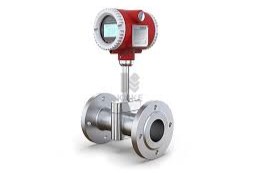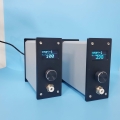Microfluidic Sensors Overview
The microflow sensor is another important component in controlling fluid flow in a microfluidic system. The microflow sensor complements the microvalves and micropumps in the control loop.
The functionality of advanced microfluidic systems depends on precise monitoring and control of flow rates, such as monitoring the flow rate of circulating cell culture media in microfluidic bioreactors and organ-on-a-chip devices.
Flow rate directly affects the flow shear stress on cultured cells in a bioreactor, as well as the delivery of oxygen and nutrients to the cells. For such applications, microflow sensors should be robust, allow continuous in-situ measurements, and be easily integrated into microfluidic chips.
Since flow measurement is the classical field of measurement technology, its sensing principles cover almost all areas of physics. Similar to other microfluidic components, the first approach to designing microflow sensors follows traditional concepts that are easily found in large-scale applications.
Due to their small geometric dimensions, the greatest advantages of microflow sensors are low energy consumption, small equipment footprint, and the ability to measure very small flow rates, ranging from nanoliters/minute to microliters/minute. The performance of microflow sensors depends on factors such as operating dynamic range, sensitivity, response time, power consumption, biocompatibility and chemical compatibility.

Basically all physical effects are temperature dependent. Flow sensors based on the thermal principle are the most common since heat transfer is accompanied by mass transfer in the fluid flow.
Thermal sensors are widely used in the detection field. The development of silicon technology has also made thermal sensors easier to manufacture, and many representative products have been developed based on silicon technology.
Micro flow sensors are categorized into non-thermal and thermal flow sensors. Micromachined non-thermal or mechanical flow sensors are mainly based on the following principles: differential pressure in microchannels or micropores, drag, lift, Coriolis force and electrohydrodynamics
Thermal flow sensors can be categorized into thermal film/heat wire sensors, calorimeter sensors, and time-of-flight sensors. Each type can be further categorized into thermo-resistive, thermo-capacitive, thermoelectric and pyroelectric based on their thermal sensing principle.

Non-thermal flow sensors
Pressure Resistance Flow Sensor
Differential pressure, resistance, lift, and other non-thermal flow sensors operate on essentially the same principle, as devices that utilize the piezoresistive effect in certain materials to measure force or pressure. These sensors are usually made of flexible materials such as silicon and contain piezoresistors - elements whose resistance varies with mechanical deformation.
When the sensor is subjected to an externally applied force, the flexible material deforms, resulting in a change in the resistance of the piezoresistor inside the sensor. This change in resistance value can be converted into a corresponding electrical signal, and precise force or pressure measurements can be realized by measuring the change in the electrical signal, thus measuring the flow rate of the fluid.
Coriolis Flow Sensors
When there is no fluid flowing through the flow tube, the flow tube is driven by an electromagnetic drive coil installed at the end of the flow tube with an amplitude of less than 1mm and a frequency of about 80Hz, and the fluid flowing into the flow tube is forced to accept the up and down vertical movement of the flow tube.
During the half cycle of upward vibration of the flow tube, the fluid resists the upward movement of the tube and exerts a downward force on the flow tube; conversely, the fluid flowing out of the flow tube exerts an upward force on the flow tube to resist the downward movement of the tube and reduce its vertical momentum.
This causes the flow tube to twist, and in the other half of the vibration cycle, the flow tube vibrates downward and twists in the opposite direction, a twisting phenomenon known as the Coriolis phenomenon, i.e., the Coriolis force.

The invention of Koch force mass flowmeter is the result of the scientific and technological community's painstaking search, it not only has the accuracy, repeatability, stability, and there is no flow-blocking elements and movable parts in the fluid channel, thus it is reliable and has a long service life, and it can also measure the flow rate of high-viscosity fluids and high-pressure gases. Its introduction has brought about a profound change in fluid measurement technology, and is regarded as the mainstream flowmeter of the 21st century.
Electrohydrodynamic Flow Sensors
The principle of electrohydrodynamic flow sensors is based on the phenomenon of electrohydrodynamics. Such sensors control the fluid by applying an electric field and use the motion characteristics of the fluid to determine the flow rate. These sensors usually include electrodes and fluid channels.
When an electric field is applied to a fluid, the electric field interacts with charges in the fluid, resulting in fluid motion. By measuring a parameter of the fluid motion, such as velocity or displacement, the sensor can determine the flow rate of the fluid.
Such sensors have been used in a number of applications, such as flow monitoring of biological samples in microfluidic systems, measurement of liquid flow rates, and the study of the fundamentals of electric field-fluid interaction.
Heat Flow Sensor
Mechanical sensors convert flow energy directly into mechanical variables such as force and pressure. Sensors such as piezoresistors convert mechanical variables into electrical signals. In contrast, thermal flow sensors convert flow energy indirectly into an electrical signal through heat transfer. Due to their simple structure and electronics, thermal sensors can be easily integrated into micromachining manufacturing processes.
Heat flow sensors typically consist of a heater and one or more temperature sensors. By measuring the heating power or heater temperature and feeding it back to the heating current, the heater can be controlled in two modes: constant heating power and constant heater temperature.
Flow rates are evaluated by measuring heating power, heater temperature, fluid temperature and thermal pulse time of flight. Three types of heat flow sensors are available: hot wire (thermal film) type, calorimeter type and time-of-flight type.
Hot wire (thermal film) sensors
A hot-wire sensor, also known as a hot-film sensor, is a sensor commonly used to measure the flow rate of a fluid. It utilizes a thermal sensor element, usually a thin hot wire or thermal film, to measure the temperature change of a fluid as it passes through, and thus infer the rate of flow of the fluid.
The principle of operation is that when a fluid flows through a hot wire sensor, the sensor's hot wire or heat film is cooled by the fluid, resulting in a reduction in temperature. Depending on the flow rate of the fluid, the cooling rate will be different. By measuring the temperature change of the sensor, the velocity of the fluid can be inferred.
Hot-wire sensors are typically used to measure the flow rate of gases or liquids and are widely used in industrial fluid flow measurement, gas flow control and liquid flow rate monitoring.
Calorimeter Sensors
Calorimeter sensors are used to measure the asymmetry of the temperature distribution around the heater, which is regulated by the fluid flow. In the case of zero flow, the temperature profile is symmetrical. When there is right-to-left flow, the temperature field becomes asymmetric. Two temperature sensors upstream and downstream measure this asymmetry and thus the flow rate.

Time-of-flight sensors
A time-of-flight (TOF) sensor is a technology that measures the distance from an object to a sensor. It determines the distance by sending light pulses and measuring the time it takes for the light signal to be sent from the sensor to the target and back.TOF sensors typically use a laser or infrared light source to send the light pulses and an optical receiver to receive the returned light signal.
The principle of operation is that the sensor sends a pulse of light and then records the time difference between the sending and returning of the light pulse. Since the speed at which light travels in a vacuum is known, the time difference can be used to calculate the time it takes for the signal to travel and thus determine the distance from the object to the sensor.
summarize
Together with micro-valves and micro-pumps, micro-flow sensors form a feedback control system for fluid transportation. Since most flow sensors realized by microtechnology are based on thermal principles, microflow sensors are classified as non-thermal or thermal. Most non-thermal flow sensors are based on pressure or force changes caused by fluid flow. The design of these flow sensors can be simplified to that of a pressure or force sensor. Thermal flow sensors are subdivided into hot film/hot wire sensors, calorimeter sensors, and time-of-flight sensors. All of these types are based on heat transfer between a heated body and a fluid. The design of thermal sensors is usually related to the design of temperature sensors. Physical phenomena such as the thermo-resistive effect, thermo-capacitive effect, thermoelectric effect, thermoelectronic effect and pyroelectric effect can be used to convert a temperature or temperature difference into an electrical signal. Thermal stresses change the resonant frequency of mechanical structures and can therefore also be used to detect temperature.
About Us
DingXu (Suzhou) Microfluidics Technology Co., Ltd. is a high-tech enterprise dedicated to the field of microfluidics. We are committed to providing customers with comprehensive microfluidic solutions, including customized microfluidic chip development, surface modification, microfluidic chip processing equipment, and microfluidic instruments. Our team boasts extensive experience and technical expertise, continuously combining professional knowledge with innovative thinking to deliver high-quality solutions. We consistently prioritize customer-centric values, embrace self-challenges, and pursue excellence. Through professionalism, innovation, and collaboration, we aim to create greater value for our customers and contribute to a brighter future in the field of microfluidics.
© 2024. All Rights Reserved. 苏ICP备2022036544号-1















